Global Glucaric Acid Market Forecast
- Glucaric acid market size poised to reach around US$2.6 Bn in 2030, up from US$1.3 Bn recorded in 2022
- Market growth likely to be at a solid CAGR of 10.5%
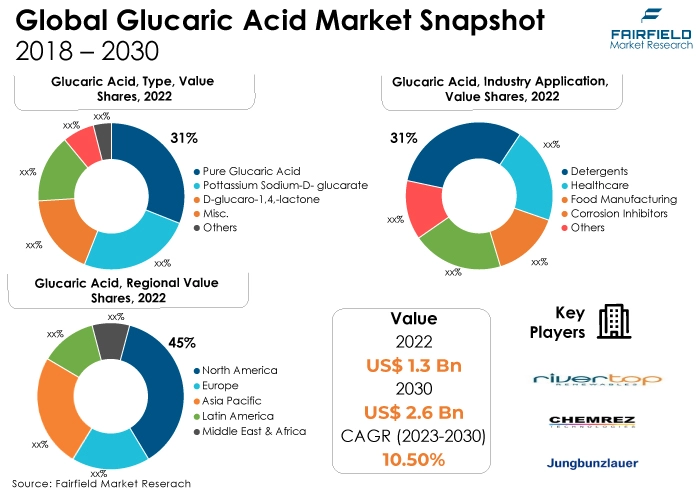
Quick Report Digest
- The key trend anticipated to fuel the growth of glucaric acid is the increasing demand from the detergent industry.
- Glucaric acid is growing due to its eco-friendly nature, as it replaces harmful chemicals in detergents, pharmaceuticals, and other industries. Its expanding applications align with sustainability trends, stringent regulations, and consumer preferences for greener, biodegradable products.
- The increasing investment in research and development is driving the growth of the Glucaric acid market by fostering innovation in production methods and exploring new applications. This investment enhances the sustainability, cost-effectiveness, and competitiveness of glucaric acid, propelling its adoption in various industries.
- Pure Glucaric Acid type has secured the largest market share due to its versatility, high purity, and suitability for various applications across industries. Its established production processes and consistent quality have made it a preferred choice, boosting its market dominance.
- Detergent applications have the largest market share in the glucaric acid market due to increasing consumer demand for eco-friendly and sustainable cleaning products. Glucaric acid's effectiveness and compliance with stringent environmental regulations drive its adoption in detergents, cementing its market leadership.
- North America dominates the glucaric acid market due to its strong emphasis on sustainability, strict environmental regulations, and well-established pharmaceutical and detergent industries. Consumer awareness and regulatory compliance drive the adoption of Glucaric acid, cementing North America's market leadership.
- The Asia Pacific region is experiencing the fastest CAGR in the glucaric acid market due to rapid industrialisation, increased environmental concerns, and a growing population. These factors drive demand for sustainable and eco-friendly alternatives like Glucaric acid, leading to its rapid growth in the region.
- Regulatory compliance presents a challenge for the glucaric acid market as stringent environmental regulations require manufacturers to adhere to eco-friendly production methods and waste disposal standards. Meeting these regulations can increase production costs and pose barriers to entry for new players.
A Look Back and a Look Forward - Comparative Analysis
The glucaric acid market was experiencing steady growth due to its applications in various industries, including detergents, food, and pharmaceuticals, primarily driven by its eco-friendly and biodegradable properties. However, the exact current market scenario may have evolved since then, influenced by factors like sustainability trends and emerging applications. For the latest insights, it's advisable to consult recent industry reports and market analyses.
The market witnessed staggered growth during the historical period 2018 – 2022. This is due to the substantial growth of the major end-use application sectors such as Detergents and Healthcare. The healthcare application of glucaric acid is growing due to its potential as an ingredient in novel pharmaceutical formulations.
Glucaric acid exhibits properties that can enhance drug delivery systems, improve bioavailability, and contribute to the development of more effective and sustainable healthcare products. The future of the glucaric acid market appears promising, with a growing emphasis on sustainable and biodegradable products.
Glucaric acid's potential in eco-friendly detergents, pharmaceuticals, and food industries is expected to drive market expansion. Additionally, ongoing research and development efforts to explore new applications and improved production methods may further fuel its demand, aligning with the increasing global focus on sustainability.
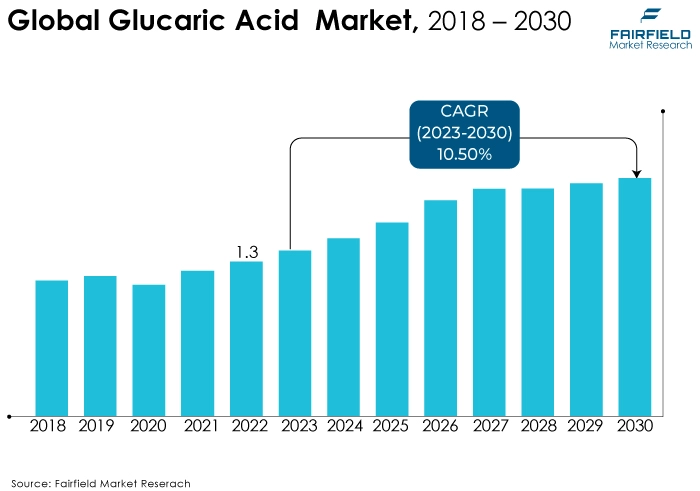
Key Growth Factors
- Extensive R&D Around Cost Efficiency and Scalability
Extensive research and development (R&D) efforts are propelling the glucaric acid market by uncovering innovative applications and sustainable production methods. R&D investments have led to the discovery of glucaric acid's diverse uses in pharmaceuticals, detergents, and food industries.
Additionally, ongoing R&D focuses on enhancing the scalability and cost-effectiveness of glucaric acid production through bio-based and environmentally friendly processes, further expanding its market potential and driving the adoption of this versatile compound in various sectors.
- Growing Perception as a Substitute for Phosphate
The emergence of glucaric acid as a substitute for phosphate is driving the glucaric Acid Market due to its eco-friendly and sustainable attributes. Phosphates have raised environmental concerns due to their adverse impact on water ecosystems.
Glucaric acid offers an alternative with similar functional properties in detergents and cleaning products while being biodegradable and phosphate-free. As regulations become stricter, the demand for phosphate alternatives like glucaric acid is rising, propelling its market growth in various industries.
- Growing Environmental Concerns
Environmental concerns are a key driver of the glucaric acid market. Growing awareness about the adverse ecological impact of traditional chemicals has led to increased demand for eco-friendly alternatives. Glucaric acid, as a biodegradable and sustainable option, addresses these concerns.
Stringent regulations on harmful chemicals, particularly in detergents and cleaning products, further accelerate its adoption. Additionally, the global push for sustainability and the need to reduce environmental footprint propel the growth of glucaric acid, making it a vital component in green chemistry and various industries.
Major Growth Barriers
- High Initial Capital, and Prohibitive Labour Costs
The glucaric acid market faces challenges due to high initial capital and labour costs. Establishing production facilities and implementing eco-friendly production methods require substantial upfront investments.
Moreover, skilled labour is essential for efficient and sustainable production, which can increase operational costs. These factors can hinder market entry for new players and put pressure on existing manufacturers to maintain competitive pricing.
However, ongoing research and innovation may help develop cost-effective production processes, mitigating these challenges and promoting the broader adoption of glucaric acid in various industries.
- Regulatory Compliance
Regulatory compliance poses challenges to the glucaric acid market due to the stringent environmental and safety regulations governing chemical manufacturing. Meeting these requirements necessitates significant investments in research, production, and documentation. Manufacturers must adhere to guidelines related to production processes, waste disposal, and labelling.
Additionally, regulatory frameworks can vary by region and may change over time, adding complexity and uncertainty. Ensuring ongoing compliance is resource-intensive and can be a barrier to entry for new players, impacting the growth and competitiveness of the glucaric acid market.
Key Trends and Opportunities to Look at
- Biotechnology and Fermentation
Biotechnology and fermentation technology are playing a pivotal role in the glucaric acid market. These advanced methods are enabling the development of more efficient, eco-friendly, and cost-effective processes for glucaric acid production.
Through the utilisation of microbial fermentation and biocatalysts, biotechnology is helping to reduce environmental impact, increase yields, and drive the sustainable growth of the glucaric acid market across various industries, including pharmaceuticals and detergents.
- Green Chemistry
Green chemistry technology is revolutionising the glucaric acid market by promoting environmentally friendly and sustainable production methods. It involves the design of efficient, non-toxic, and eco-compatible chemical processes for glucaric acid synthesis, aligning with sustainability goals.
By minimising waste, reducing hazardous materials, and conserving resources, green chemistry not only ensures the environmental friendliness of glucaric acid production but also enhances its competitiveness in a market increasingly focused on eco-friendly solutions.
- Biocatalysis
Biocatalysis technology is gaining prominence in the glucaric acid market as it offers an environmentally friendly and efficient route for synthesis. Enzymes and microorganisms serve as biocatalysts to facilitate glucaric acid production, reducing the need for harsh chemicals and energy-intensive processes.
This sustainable approach aligns with green chemistry principles and contributes to the growth of the market by providing a cleaner and more sustainable production method for glucaric acid.
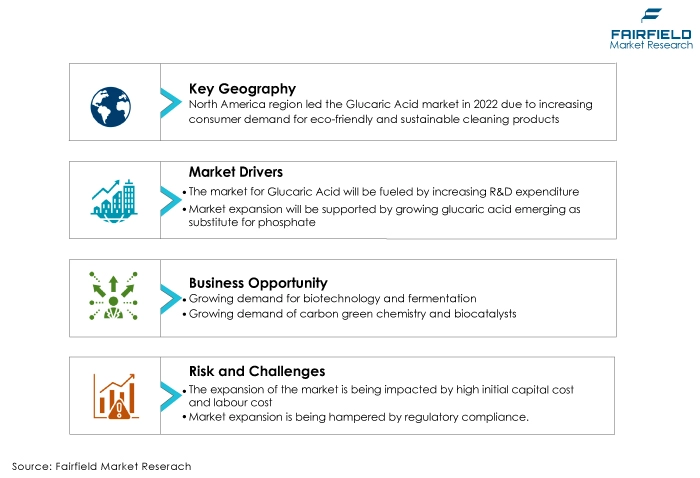
How Does the Regulatory Scenario Shape this Industry?
The regulatory scenario plays a crucial role in shaping the glucaric acid market. Government agencies and environmental organisations worldwide are increasingly imposing strict regulations on chemicals and their environmental impact. This has led to a growing demand for eco-friendly and sustainable alternatives, such as glucaric acid, which aligns with these stringent regulations.
In the detergent industry, where phosphates have been widely used but are now heavily regulated due to their negative environmental effects, the adoption of glucaric acid as a phosphate substitute has been driven by the need for compliance with these regulations.
Additionally, regulatory support for green chemistry initiatives and sustainable manufacturing practices further encourages the adoption of glucaric acid in various industries. As governments and international bodies promote the reduction of greenhouse gas emissions and environmental conservation, the glucaric acid market is positioned to benefit from its eco-friendly attributes and compliance with evolving regulatory standards.
However, companies operating in this market must continuously monitor and adapt to changing regulations to ensure long-term compliance and market viability.
Fairfield’s Ranking Board
Top Segments
- Pure Glucaric Acid Sought-after
Pure glucaric acid has captured the largest market share in the glucaric acid market due to its versatility and wide range of applications. Its high purity makes it suitable for use in pharmaceuticals, detergents, food additives, and various other industries where stringent quality standards are essential.
Moreover, its well-established production processes and consistent quality have bolstered its market dominance. As enterprises increasingly seek sustainable and eco-friendly alternatives, the purity and proven performance of pure glucaric acid have positioned it as the preferred choice, contributing to its dominant market share.
The 4-lactone type of glucaric acid is experiencing the highest CAGR in the market due to its unique properties and emerging applications. 4-lactone glucaric acid is more stable and less prone to hydrolysis than pure glucaric acid, making it attractive for various industries.
It finds applications in pharmaceuticals, where stability is crucial, and as a precursor for specialty chemicals. Its versatility and potential to meet evolving industry needs are driving its rapid growth, positioning it as a key player in the expanding glucaric acid market.
- Detergents Represent the Top Area of Application
The detergent application has captured the largest market share in the glucaric acid market due to the increasing demand for eco-friendly and sustainable cleaning products. Glucaric acid serves as a phosphate substitute in detergents, offering effective cleaning while being environmentally friendly.
With stringent regulations limiting the use of phosphates in detergents due to their adverse environmental impact, the adoption of glucaric acid has surged. Consumers' growing preference for green and biodegradable detergents has further boosted its market share, making it a key ingredient in the detergent industry's shift toward sustainability.
The healthcare application is experiencing the highest CAGR in the glucaric acid market due to its expanding use in pharmaceutical formulations. Glucaric acid offers potential benefits in cancer therapy, liver detoxification, and cardiovascular health. As research on its therapeutic properties, the demand for glucaric acid in healthcare is surging.
Additionally, its biocompatibility and biodegradability make it an attractive option for drug delivery systems, contributing to its rapid growth as the healthcare sector increasingly explores its innovative applications.
Regional Outlook
North America in the Bandwagon
North America has secured the largest market share in the glucaric acid market due to several factors. Firstly, the region's strong emphasis on sustainability and eco-friendly products has driven the demand for glucaric acid as a green alternative in various industries.
Additionally, stringent environmental regulations in the US, and Canada have restricted the use of certain chemicals, leading to the adoption of glucaric acid in detergent formulations.
Furthermore, North America has a well-established pharmaceutical industry that increasingly utilises glucaric acid for drug development. These factors, combined with robust research and development activities, have propelled North America to a dominant position in the glucaric acid market.
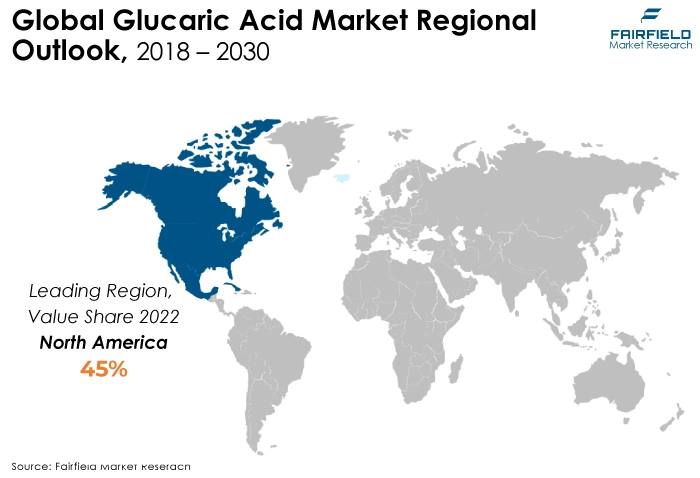
Asia Pacific
The Asia Pacific region is experiencing the highest CAGR in the glucaric acid market due to several factors. Rapid industrialisation, coupled with increasing environmental concerns, has boosted demand for eco-friendly alternatives like glucaric acid. Growing populations and urbanisation are driving the need for sustainable cleaning products, such as glucaric acid-based detergents.
Moreover, the region's expanding pharmaceutical and healthcare sectors are adopting glucaric acid for its therapeutic potential and drug delivery applications. As Asia Pacific continues to prioritise sustainability and green chemistry, the market for glucaric acid is poised for substantial growth.
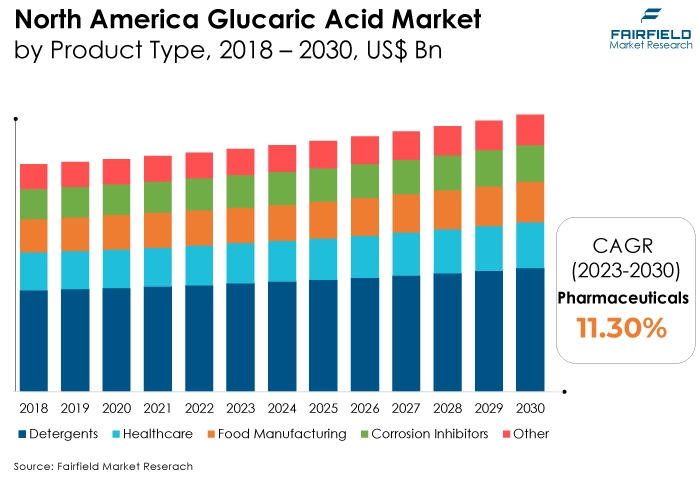
Fairfield’s Competitive Landscape Analysis
The global glucaric acid market is consolidated, with fewer major players present globally. The key players are introducing new products and working on the distribution channels to enhance their worldwide presence. Moreover, Fairfield Market Research expects more consolidation over the coming years.
Who are the Leaders in the Global Glucaric Acid Space?
- Rivertop Renewables
- Chemrez Technologies Inc.
- Jungbunzlauer
- Haihang Industry Co., Ltd.
- Merck KGaA
- Santa Cruz Biotechnology, Inc.
- Shandong Baovi Energy Technology Co., Ltd.
- Parchem Fine & Specialty Chemicals
- Tokyo Chemical Industry Co., Ltd.
- Innospec Inc.
- Jigs Chemical
Significant Company Developments
New Product Launch
- October 2022: MyKirei, a brand under KAO, has launched an innovative Easy-Spray Laundry Detergent designed for cleaning clothes and household linens. This revolutionary product offers a compact and refillable alternative to bulky, space-consuming detergent bottles. This innovation not only contributes to environmental sustainability but also enhances the company's growth prospects.
Distribution Agreement
- May 2022: Procter & Gamble (P&G) has established its inaugural liquid detergent manufacturing facility in India, situated on the outskirts of Hyderabad. This significant venture represents an investment of INR 200 crore (equivalent to US$ 26.83 Mn).
An Expert’s Eye
Demand and Future Growth
As per Fairfield’s analysis, growth in detergents is driving the market. The glucaric acid market is witnessing increasing demand and is poised for future growth. A rising emphasis on sustainable and eco-friendly alternatives in various industries drives the market. Glucaric acid's applications in detergents, pharmaceuticals, and other sectors are expanding, supported by stringent environmental regulations and consumer preferences.
Additionally, ongoing research and development efforts are exploring new applications and cost-effective production methods. As global sustainability goals gain momentum, the glucaric acid market is expected to continue its growth trajectory, offering eco-conscious solutions across a range of industries.
Supply Side of the Market
The Glucaric acid market is global, with several countries actively participating. Major players include the United States, where sustainability initiatives and detergent applications drive the market. Canada also plays a significant role, given its stringent environmental regulations. In Europe, countries like Germany, the United Kingdom, and France are adopting glucaric acid in various industries.
Additionally, Asia Pacific nations like China, and India are emerging as key markets, driven by rapid industrialisation and environmental concerns. These countries collectively contribute to the growth and global reach of the glucaric acid market. The major raw materials required for glucaric acid production include glucose, calcium hydroxide, and various catalysts.
Glucose serves as the primary starting material, while calcium hydroxide is used in the catalytic oxidation process. Stimuli, such as manganese or cobalt compounds are essential for efficient conversion.
Several chemical manufacturers produce these raw materials, including companies like BASF, Dow Chemical Company, Evonik Industries, and Sigma-Aldrich (now part of MilliporeSigma). These companies supply essential chemicals and catalysts to support the production of glucaric acid by various manufacturers in the industry.
The Global Glucaric Acid Market is Segmented as Below:
By Type:
- Pure Glucaric Acid
- Calcium-D-Glucarate
- Potassium Sodium-D-Glucarate
- D-glucaro-1,4-lactone
- Others
By Application:
- Detergents
- Pharmaceuticals
- Food Manufacturing
- Corrosion Inhibitors
- Others
By Geographic Coverage:
- North America
- U.S.
- Canada
- Europe
- Germany
- U.K.
- France
- Italy
- Turkey
- Russia
- Rest of Europe
- Asia Pacific
- China
- Japan
- South Korea
- India
- Southeast Asia
- Rest of Asia Pacific
- Latin America
- Brazil
- Mexico
- Argentina
- Rest of Latin America
- Middle East & Africa
- GCC
- South Africa
- Egypt
- Nigeria
- Rest of the Middle East & Africa
1. Executive Summary
1.1. Global Glucaric Acid Market Snapshot
1.2. Future Projections
1.3. Key Market Trends
1.4. Regional Snapshot, by Value, 2022
1.5. Analyst Recommendations
2. Market Overview
2.1. Market Definitions and Segmentations
2.2. Market Dynamics
2.2.1. Drivers
2.2.2. Restraints
2.2.3. Market Opportunities
2.3. Value Chain Analysis
2.4. Porter’s Five Forces Analysis
2.5. Covid-19 Impact Analysis
2.5.1. Supply
2.5.2. Demand
2.6. Impact of Ukraine-Russia Conflict
2.7. Economic Overview
2.7.1. World Economic Projections
2.8. PESTLE Analysis
3. Global Glucaric Acid Market Outlook, 2018 - 2030
3.1. Global Glucaric Acid Market Outlook, by Type, Value (US$ Bn), 2018 - 2030
3.1.1. Key Highlights
3.1.1.1. Pure Glucaric Acid
3.1.1.2. Calcium-D-Glucarate
3.1.1.3. Potassium Sodium-D-Glucarate
3.1.1.4. D-glucaro-1, 4-lactone
3.1.1.5. Others
3.2. Global Glucaric Acid Market Outlook, by Application, Value (US$ Bn), 2018 - 2030
3.2.1. Key Highlights
3.2.1.1. Detergents
3.2.1.2. Pharmaceuticals
3.2.1.3. Food Manufacturing
3.2.1.4. Corrosion Inhibitors
3.2.1.5. Others
3.3. Global Glucaric Acid Market Outlook, by Region, Value (US$ Bn), 2018 - 2030
3.3.1. Key Highlights
3.3.1.1. North America
3.3.1.2. Europe
3.3.1.3. Asia Pacific
3.3.1.4. Latin America
3.3.1.5. Middle East & Africa
4. North America Glucaric Acid Market Outlook, 2018 - 2030
4.1. North America Glucaric Acid Market Outlook, by Type, Value (US$ Bn), 2018 - 2030
4.1.1. Key Highlights
4.1.1.1. Pure Glucaric Acid
4.1.1.2. Calcium-D- glucarate
4.1.1.3. Potassium Sodium-D- glucarate
4.1.1.4. D-glucaro-1, 4-lactone
4.1.1.5. Others
4.2. North America Glucaric Acid Market Outlook, by Application, Value (US$ Bn), 2018 - 2030
4.2.1. Key Highlights
4.2.1.1. Detergents
4.2.1.2. Pharmaceuticals
4.2.1.3. Food Manufacturing
4.2.1.4. Corrosion Inhibitors
4.2.1.5. Others
4.2.2. BPS Analysis/Market Attractiveness Analysis
4.3. North America Glucaric Acid Market Outlook, by Country, Value (US$ Bn), 2018 - 2030
4.3.1. Key Highlights
4.3.1.1. U.S. Glucaric Acid Market, by Type, Value (US$ Bn), 2018 - 2030
4.3.1.2. U.S. Glucaric Acid Market, by Application, Value (US$ Bn), 2018 - 2030
4.3.1.3. Canada Glucaric Acid Market, by Type, Value (US$ Bn), 2018 - 2030
4.3.1.4. Canada Glucaric Acid Market, by Application, Value (US$ Bn), 2018 - 2030
4.3.2. BPS Analysis/Market Attractiveness Analysis
5. Europe Glucaric Acid Market Outlook, 2018 - 2030
5.1. Europe Glucaric Acid Market Outlook, by Type, Value (US$ Bn), 2018 - 2030
5.1.1. Key Highlights
5.1.1.1. Pure Glucaric Acid
5.1.1.2. Calcium-D-Glucarate
5.1.1.3. Potassium Sodium-D-Glucarate
5.1.1.4. D-glucaro-1, 4-lactone
5.1.1.5. Others
5.2. Europe Glucaric Acid Market Outlook, by Application, Value (US$ Bn), 2018 - 2030
5.2.1. Key Highlights
5.2.1.1. Detergents
5.2.1.2. Pharmaceuticals
5.2.1.3. Food Manufacturing
5.2.1.4. Corrosion Inhibitors
5.2.1.5. Others
5.2.2. BPS Analysis/Market Attractiveness Analysis
5.3. Europe Glucaric Acid Market Outlook, by Country, Value (US$ Bn), 2018 - 2030
5.3.1. Key Highlights
5.3.1.1. Germany Glucaric Acid Market, by Type, Value (US$ Bn), 2018 - 2030
5.3.1.2. Germany Glucaric Acid Market, by Application, Value (US$ Bn), 2018 - 2030
5.3.1.3. U.K. Glucaric Acid Market, by Type, Value (US$ Bn), 2018 - 2030
5.3.1.4. U.K. Glucaric Acid Market, by Application, Value (US$ Bn), 2018 - 2030
5.3.1.5. France Glucaric Acid Market, by Type, Value (US$ Bn), 2018 - 2030
5.3.1.6. France Glucaric Acid Market, by Application, Value (US$ Bn), 2018 - 2030
5.3.1.7. Italy Glucaric Acid Market, by Type, Value (US$ Bn), 2018 - 2030
5.3.1.8. Italy Glucaric Acid Market, by Application, Value (US$ Bn), 2018 - 2030
5.3.1.9. Turkey Glucaric Acid Market, by Type, Value (US$ Bn), 2018 - 2030
5.3.1.10. Turkey Glucaric Acid Market, by Application, Value (US$ Bn), 2018 - 2030
5.3.1.11. Russia Glucaric Acid Market, by Type, Value (US$ Bn), 2018 - 2030
5.3.1.12. Russia Glucaric Acid Market, by Application, Value (US$ Bn), 2018 - 2030
5.3.1.13. Rest of Europe Glucaric Acid Market, by Type, Value (US$ Bn), 2018 - 2030
5.3.1.14. Rest of Europe Glucaric Acid Market, by Application, Value (US$ Bn), 2018 - 2030
5.3.2. BPS Analysis/Market Attractiveness Analysis
6. Asia Pacific Glucaric Acid Market Outlook, 2018 - 2030
6.1. Asia Pacific Glucaric Acid Market Outlook, by Type, Value (US$ Bn), 2018 - 2030
6.1.1. Key Highlights
6.1.1.1. Pure Glucaric Acid
6.1.1.2. Calcium-D-Glucarate
6.1.1.3. Potassium Sodium-D-Glucarate
6.1.1.4. D-glucaro-1, 4-lactone
6.1.1.5. Others
6.2. Asia Pacific Glucaric Acid Market Outlook, by Application, Value (US$ Bn), 2018 - 2030
6.2.1. Key Highlights
6.2.1.1. Detergents
6.2.1.2. Pharmaceuticals
6.2.1.3. Food Manufacturing
6.2.1.4. Corrosion Inhibitors
6.2.1.5. Others
6.2.2. BPS Analysis/Market Attractiveness Analysis
6.3. Asia Pacific Glucaric Acid Market Outlook, by Country, Value (US$ Bn), 2018 - 2030
6.3.1. Key Highlights
6.3.1.1. China Glucaric Acid Market, by Type, Value (US$ Bn), 2018 - 2030
6.3.1.2. China Glucaric Acid Market by Application, Value (US$ Bn), 2018 - 2030
6.3.1.3. Japan Glucaric Acid Market, by Type, Value (US$ Bn), 2018 - 2030
6.3.1.4. Japan Glucaric Acid Market, by Application, Value (US$ Bn), 2018 - 2030
6.3.1.5. South Korea Glucaric Acid Market, by Type, Value (US$ Bn), 2018 - 2030
6.3.1.6. South Korea Glucaric Acid Market, by Application, Value (US$ Bn), 2018 - 2030
6.3.1.7. India Glucaric Acid Market, by Type, Value (US$ Bn), 2018 - 2030
6.3.1.8. India Glucaric Acid Market, by Application, Value (US$ Bn), 2018 - 2030
6.3.1.9. Southeast Asia Glucaric Acid Market, by Type, Value (US$ Bn), 2018 - 2030
6.3.1.10. Southeast Asia Glucaric Acid Market, by Application, Value (US$ Bn), 2018 - 2030
6.3.1.11. Rest of Asia Pacific Glucaric Acid Market, by Type, Value (US$ Bn), 2018 - 2030
6.3.1.12. Rest of Asia Pacific Glucaric Acid Market, by Application, Value (US$ Bn), 2018 - 2030
6.3.2. BPS Analysis/Market Attractiveness Analysis
7. Latin America Glucaric Acid Market Outlook, 2018 - 2030
7.1. Latin America Glucaric Acid Market Outlook, by Type, Value (US$ Bn), 2018 - 2030
7.1.1. Key Highlights
7.1.1.1. Pure Glucaric Acid
7.1.1.2. Calcium-D- Glucarate
7.1.1.3. Potassium Sodium-D-Glucarate
7.1.1.4. D-glucaro-1, 4-lactone
7.1.1.5. Others
7.2. Latin America Glucaric Acid Market Outlook, by Application, Value (US$ Bn), 2018 - 2030
7.2.1. Key Highlights
7.2.1.1. Detergents
7.2.1.2. Pharmaceuticals
7.2.1.3. Food Manufacturing
7.2.1.4. Corrosion Inhibitors
7.2.1.5. Others
7.2.2. BPS Analysis/Market Attractiveness Analysis
7.3. Latin America Glucaric Acid Market Outlook, by Country, Value (US$ Bn), 2018 - 2030
7.3.1. Key Highlights
7.3.1.1. Brazil Glucaric Acid Market, by Type, Value (US$ Bn), 2018 - 2030
7.3.1.2. Brazil Glucaric Acid Market, by Application, Value (US$ Bn), 2018 - 2030
7.3.1.3. Mexico Glucaric Acid Market, by Type, Value (US$ Bn), 2018 - 2030
7.3.1.4. Mexico Glucaric Acid Market, by Application, Value (US$ Bn), 2018 - 2030
7.3.1.5. Argentina Glucaric Acid Market, by Type, Value (US$ Bn), 2018 - 2030
7.3.1.6. Argentina Glucaric Acid Market, by Application, Value (US$ Bn), 2018 - 2030
7.3.1.7. Rest of Latin America Glucaric Acid Market, by Type, Value (US$ Bn), 2018 - 2030
7.3.1.8. Rest of Latin America Glucaric Acid Market, by Application, Value (US$ Bn), 2018 - 2030
7.3.2. BPS Analysis/Market Attractiveness Analysis
8. Middle East & Africa Glucaric Acid Market Outlook, 2018 - 2030
8.1. Middle East & Africa Glucaric Acid Market Outlook, by Type, Value (US$ Bn), 2018 - 2030
8.1.1. Key Highlights
8.1.1.1. Pure Glucaric Acid
8.1.1.2. Calcium-D-Glucarate
8.1.1.3. Potassium Sodium-D-Glucarate
8.1.1.4. D-glucaro-1, 4-lactone
8.1.1.5. Others
8.2. Middle East & Africa Glucaric Acid Market Outlook, by Application, Value (US$ Bn), 2018 - 2030
8.2.1. Key Highlights
8.2.1.1. Detergents
8.2.1.2. Pharmaceuticals
8.2.1.3. Food Manufacturing
8.2.1.4. Corrosion Inhibitors
8.2.1.5. Others
8.2.2. BPS Analysis/Market Attractiveness Analysis
8.3. Middle East & Africa Glucaric Acid Market Outlook, by Country, Value (US$ Bn), 2018 - 2030
8.3.1. Key Highlights
8.3.1.1. GCC Glucaric Acid Market, by Type, Value (US$ Bn), 2018 - 2030
8.3.1.2. GCC Glucaric Acid Market, by Application, Value (US$ Bn), 2018 - 2030
8.3.1.3. South Africa Glucaric Acid Market, by Type, Value (US$ Bn), 2018 - 2030
8.3.1.4. South Africa Glucaric Acid Market, by Application, Value (US$ Bn), 2018 - 2030
8.3.1.5. Egypt Glucaric Acid Market, by Type, Value (US$ Bn), 2018 - 2030
8.3.1.6. Egypt Glucaric Acid Market, by Application, Value (US$ Bn), 2018 - 2030
8.3.1.7. Nigeria Glucaric Acid Market, by Type, Value (US$ Bn), 2018 - 2030
8.3.1.8. Nigeria Glucaric Acid Market, by Application, Value (US$ Bn), 2018 - 2030
8.3.1.9. Rest of Middle East & Africa Glucaric Acid Market, by Type, Value (US$ Bn), 2018 - 2030
8.3.1.10. Rest of Middle East & Africa Glucaric Acid Market, by Application, Value (US$ Bn), 2018 - 2030
8.3.2. BPS Analysis/Market Attractiveness Analysis
9. Competitive Landscape
9.1. Manufacturer vs Application Heatmap
9.2. Company Market Share Analysis, 2022
9.3. Competitive Dashboard
9.4. Company Profiles
9.4.1. Rivertop Renewables
9.4.1.1. Company Overview
9.4.1.2. Product Portfolio
9.4.1.3. Financial Overview
9.4.1.4. Business Strategies and Development
9.4.2. Chemrez Technologies Inc.
9.4.2.1. Company Overview
9.4.2.2. Product Portfolio
9.4.2.3. Financial Overview
9.4.2.4. Business Strategies and Development
9.4.3. Jungbunzlauer Suisse AG
9.4.3.1. Company Overview
9.4.3.2. Product Portfolio
9.4.3.3. Financial Overview
9.4.3.4. Business Strategies and Development
9.4.4. Haihang Industry Co., Ltd.
9.4.4.1. Company Overview
9.4.4.2. Product Portfolio
9.4.4.3. Financial Overview
9.4.4.4. Business Strategies and Development
9.4.5. Merck KGaA
9.4.5.1. Company Overview
9.4.5.2. Product Portfolio
9.4.5.3. Financial Overview
9.4.5.4. Business Strategies and Development
9.4.6. Logos
9.4.6.1. Company Overview
9.4.6.2. Product Portfolio
9.4.6.3. Financial Overview
9.4.6.4. Business Strategies and Development
9.4.7. Santa Cruz Biotechnology, Inc.
9.4.7.1. Company Overview
9.4.7.2. Product Portfolio
9.4.7.3. Financial Overview
9.4.7.4. Business Strategies and Development
9.4.8. Yifan Biotechnology Group Co., Ltd.
9.4.8.1. Company Overview
9.4.8.2. Product Portfolio
9.4.8.3. Financial Overview
9.4.8.4. Business Strategies and Development
9.4.9. Anhui Huailong Biochem Co., Ltd.
9.4.9.1. Company Overview
9.4.9.2. Product Portfolio
9.4.9.3. Financial Overview
9.4.9.4. Business Strategies and Development
9.4.10. Shandong Baovi Energy Technology Co., Ltd.
9.4.10.1. Company Overview
9.4.10.2. Product Portfolio
9.4.10.3. Financial Overview
9.4.10.4. Business Strategies and Development
9.4.11. Haihang Industry Co., Ltd.
9.4.11.1. Company Overview
9.4.11.2. Product Portfolio
9.4.11.3. Financial Overview
9.4.11.4. Business Strategies and Development
9.4.12. Parchem Fine & Specialty Chemicals
9.4.12.1. Company Overview
9.4.12.2. Product Portfolio
9.4.12.3. Financial Overview
9.4.12.4. Business Strategies and Development
9.4.13. Tokyo Chemical Industry Co., Ltd.
9.4.13.1. Company Overview
9.4.13.2. Product Portfolio
9.4.13.3. Financial Overview
9.4.13.4. Business Strategies and Development
9.4.14. Innospec Inc.
9.4.14.1. Company Overview
9.4.14.2. Product Portfolio
9.4.14.3. Financial Overview
9.4.14.4. Business Strategies and Development
9.4.15. Jigs Chemical
9.4.15.1. Company Overview
9.4.15.2. Product Portfolio
9.4.15.3. Financial Overview
9.4.15.4. Business Strategies and Development
10. Appendix
10.1. Research Methodology
10.2. Report Assumptions
10.3. Acronyms and Abbreviations
|
BASE YEAR |
HISTORICAL DATA |
FORECAST PERIOD |
UNITS |
|||
|
2022 |
|
2018 - 2022 |
2023 - 2030 |
Value: US$ Million |
||
|
REPORT FEATURES |
DETAILS |
|
Type Coverage |
|
|
Application Coverage |
|
|
Geographical Coverage |
|
|
Leading Companies |
|
|
Report Highlights |
Key Market Indicators, Macro-micro economic impact analysis, Technological Roadmap, Key Trends, Driver, Restraints, and Future Opportunities & Revenue Pockets, Porter’s 5 Forces Analysis, Historical Trend (2019-2021), Market Estimates and Forecast, Market Dynamics, Industry Trends, Competition Landscape, Category, Region, Country-wise Trends & Analysis, COVID-19 Impact Analysis (Demand and Supply Chain) |
